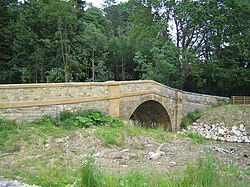River Rye, Yorkshire


The River Rye runs through Yorkshire, entirely within the North Riding until it discharges its waters into the River Derwent, which forms the boundary of the East Riding. The upper course of the river forms Ryedale, one of the fair dales in the easterly parts of the county.
The Rye rises just south of the Cleveland Hills, east of Osmotherley, and flows through Hawnby, Rievaulx, Helmsley, Nunnington, West and East Ness, Butterwick, Brawby, and Ryton, before joining the River Derwent near Malton. It gives a name to two of these villages: Rievaulx (a name filtered through French from 'Rye Vale') and Ryton.
Course
The upper valley of the river is known as Rye Dale. The river rises at Rye Head in the Cleveland Hills, then collects the River Seph which flows along Bilsdale. It passes Rievaulx Abbey then enters the Vale of Pickering at Helmsley. In its eastward course from Helmsley the Rye receives the River Dove from Farndale which has previously added the Hodge Beck from Bransdale. Hodge Beck is partly swallowed by the limestone aquifer in Kirkdale and issues again further down the valley. Kirkbymoorside is on the River Dove which, like Hodge Beck has a partly subterranean course. Rosedale sends down the River Seven which comes by Sinnington to join the Rye.
The steep sided Newtondale gives Pickering Beck which joins the Costa Beck before it enters the River Rye just before its mouth.
Lands of the dale and meadow
The upstream part of the Rye's basin covers about 95 square miles. It covers the River Rye and its tributaries from its source to its confluence with the River Dove near the village of East Ness.
This area is mainly rural with a few dispersed villages. The upper dale is dominated by upland moors and part of the North York Moors National Park is within the Rye's lands. Here the land use is largely as managed grassland. Downstream, as the river approaches Rievaulx and Helmsley the land use is a mixture of managed grassland and arable farming. There are also some pockets of forestry and woodland on the land close to the river.
Abstraction from the river is mainly to supply a fish farm at Harome and this water is returned to the river. There are two wastewater treatment works at Helmsley and Sproxton. The ecology and fisheries have a very high sensitivity to changers in water flow in this area.[1]
The lower course of the river, from East Ness to the River Derwent just beyond Howe Bridge, the land is lower meadowland. The main lower tributaries of the Rye are the River Riccal, River Dove (with Hodge Beck), River Seven, Costa Beck and Pickering Beck.
Two small market towns, Pickering and Kirkbymoorside are the largest places in the area.
To the south-west rise the undulating landscape of the Howardian Hills.

There are many sites in the Rye catchment area which have designated status as 'Special Protection Areas', 'Special Areas of Conservation' and 'Sites of Special Scientific Interest'.
Duncombe Park is a 'National Nature Reserve' and the Howardian Hills are an 'Area of Outstanding Natural Beauty'.
Historical interest

The upland streams of the Rye and its tributaries have powered water mills for many centuries. There were certainly three at Pickering and others at Kirkby Mills, near Kirkbymoorside.[2] A mill at Bransdale is owned by the National Trust, though not open to visitors.
Rievaulx Abbey was established on the banks of the Rye on land given by Walter l'Espec of Helmsley and took its name from a literal translation of Rye Valley from the French. The monks of Rievaulx later diverted the river away from the abbey buildings.[3]
On the Costa Beck south of Pickering traces of a prehistoric settlement were excavated in the late 19th century.[4][5]
Outside links
| ("Wikimedia Commons" has material about River Rye, Yorkshire) |
References
- ↑ "The Derwent Catchment Abstraction Management Strategy" (PDF). Environment Agency. 2006. http://publications.environment-agency.gov.uk/pdf/GENE0206BKFB-e-e.pdf. Retrieved 23 November 2009.
- ↑ Home, Gordon (1905). The Evolution of an English Town: being the story of the ancient town of Pickering in Yorkshire. J.M. Dent & co. ISBN 1-4375-2268-8.
- ↑ Frank, George (1888). Ryedale and North Yorkshire antiquities. Sampson Brothers.
- ↑ Snowden, Keith (1997). Pickering through the ages: a concise history of this ancient North Yorkshire town. Pickering: Castleden. ISBN 0-9527548-1-9.
- ↑ Rushton, John (2003). The history of Ryedale: from the earliest times to the year 2000. Blackthorn Press local histories. Blackthorne. ISBN 0-9540535-1-6.
